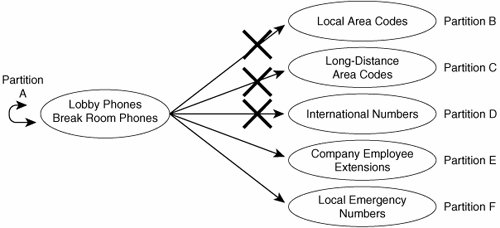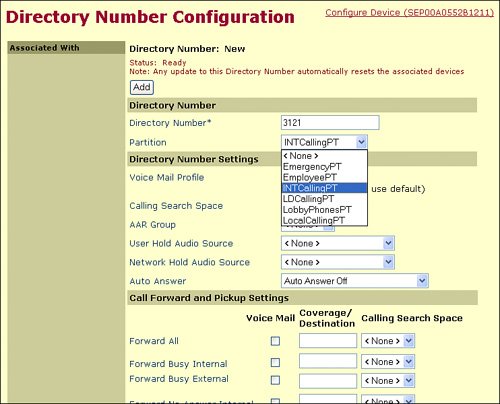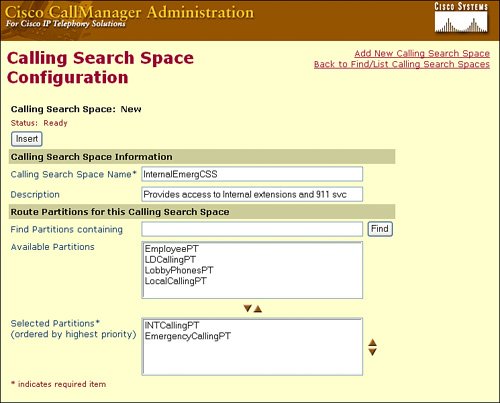Partitions and Calling Search Spaces Overview
A partition is a group of directory numbers (DNs) with similar accessibility. A calling search space defines which partitions are accessible to a particular device. A device can call only the DNs located in the partitions that are part of its calling search space.
A partition comprises a logical grouping of directory numbers (DNs) and route patterns with similar reachability characteristics. Items that are placed in partitions include DNs and route patterns (or anything else that has a directory number). For simplicity, partition names usually reflect their characteristics, such as "NYLongDistancePT," "NY911PT," and so on.
A calling search space is an ordered list of partitions that Cisco CallManager digit analysis looks at before a telephone call is placed. Calling search spaces then determine the partitions that calling devices, such as Cisco IP Phones, Cisco IP SoftPhones, and gateways, can reach when attempting to complete a call. If a device attempts to reach a route pattern or DN that is not contained in one of the partitions in its calling search space, it receives a fast busy signal (or a prerecorded message played by the annunciator service).
Items that can be placed in partitions all have a dialable pattern, which includes phone lines, route patterns, translation patterns, computer telephony integration (CTI) route group lines, CTI port lines, voice-mail ports, and Meet-Me conference numbers. In short, you can place absolutely anything that has a directory number into a partition. To do this, you group common numbers together. For example, you could create an internal number partition (perhaps named INTERNAL_PT) that contains all numbers internal to the organization, an emergency partition (named EMERGENCY_PT) that contains route patterns representing emergency numbers such as 911, and a local PSTN partition (named LOCAL_PT) that contains route patterns representing local PSTN numbers. By doing this, you have grouped the numbers to assign the calling restrictions. By default, everything belongs to the partition (or no partition assignment), which is why there are no calling restrictions.
Conversely, you can assign a calling search space to all devices capable of dialing a call, such as telephones, telephone lines, gateways, and applications (via their CTI route groups or voice-mail ports). The calling search space contains nothing more than an ordered list of partitions. When you assign a calling search space to a device, that device can reach whatever is in the partitions listed in the calling search space. For example, you could create a calling search space named INT_EMG_CSS that contains just the internal and emergency partitions (INTERNAL_PT and EMERGENCY_PT mentioned in the previous paragraph). By assigning this to an IP Phone, you will have restricted it to only dialing internal extensions and emergency numbers.
Note
Regardless of the calling search space assigned, all devices are able to reach any number assigned to the partition. Because of this, Cisco recommends that you should never leave numbers assigned to the partition.
As shown in Figure 13-1, the DNs of lobby phones and break room phones are placed into partition A. Partitions B, C, D, E, and F contain the route patterns to reach local numbers, long-distance numbers, international numbers, and company extensions.
Figure 13-1. Partition and Calling Search Space Example

The calling search space for the lobby phones includes only the partitions containing the company extensions and the local emergency numbers. Therefore, a lobby phone located in partition A has a calling search space containing partition A, E, and F and can dial only company destinations, including the break room (in other words, devices belonging to the same partition) and local emergency numbers (for example, 911 in the United States).
Note
In addition to assigning calling search spaces to the phone or directory number, you can assign calling search spaces to the call forwarding fields of an IP Phone (call forward busy, call forward no answer, and so on). This allows you to place different calling restrictions beyond normal calling when a user forwards their phone.
Calling Search Spaces Applied to Gateways and Intercluster Trunks
In addition to applying calling search spaces to the IP Phones in the network, you must also apply them to the gateways and intercluster trunks. By default, the gateways and intercluster trunks of the network are assigned a calling search space of . This calling search space can only access the directory numbers and route patterns assigned to the partition.
Tip
The default state of ALL devices in the CallManager cluster is the following:
Partition:
Calling Search Space:
Even though it might appear as though these mean "no assignment," there is an unconfigurable partition and calling search space called . The calling search space only has access to the devices in the partition. As you begin to assign directory numbers and route patterns to partitions other than , any devices with the calling search space (default) will lose access to the reassigned numbers.
The previously mentioned tip warrants special consideration when dealing with gateways and intercluster trunks. Because these devices are assigned the default calling search space of , they will begin to lose access to the cluster directory numbers as you assign them to other partitions. The directory numbers that the gateways and intercluster trunks have access to affect inbound calls to the cluster.
For example, you could create a calling search space named INT_LOC_CSS that only allowed access to directory numbers assigned to the Internal (INTERNAL_PT) and Local PSTN (LOCAL_PT) partitions. If this INT_LOCAL_CSS calling search space were applied to an Intercluster Trunk to a remote CallManager cluster, any calls coming inbound from the remote cluster would only be able to reach the internal and local PSTN extensions. This feature is useful when you do not have administrative control of the remote cluster but have the need to configure call restrictions into your cluster from the remote devices.
Note
This feature works identically for gateway devices configured in the CallManager cluster. The calling search space applied to gateway devices affect calls coming inbound (into the cluster) from the gateway. It does not affect calls outbound to the gateway from the devices in the cluster.
Partition Configuration
To configure partitions, choose Route Plan > Class of Control > Partition. When the Find and List Partition window appears, click the Add a New Partition link. The Partition Configuration window that is shown in Figure 13-2 appears. From here, you can add a maximum of 75 partitions at a time using the following syntax:
,
Figure 13-2. Partition Configuration Window

Note
Class of Control is a new submenu item under the Route Plan menu in Release 4.1 of Cisco CallManager. The Class of Control submenu includes partitions, calling search spaces, and time-of-day routing items.
Cisco CallManager Administration requires that you enter the partition name. However, adding a description for the partition can be useful for documentation purposes.
Using partitions allows you to group DNs with similar characteristics together. For example, the network administrator at ABC Company must allow certain individuals to call the DNs in the 1xxx and 2xxx ranges. Before assigning the DNs to a partition, the administrator must first configure the partitions using the Partition Configuration window in Cisco CallManager Administration. The administrator could add the necessary partitions using the following format:
- DN_1XXX, Directory Numbers 1000-1999
- DN_2XXX, Directory Numbers 2000-2999
After the administrator adds the partitions, DNs must be assigned. To do this, the administrator must enter the configuration mode of the telephones or route patterns that have the DNs, proceed to the Directory Number Configuration window, and choose the newly created partition from the menu, as shown in Figure 13-3.
Figure 13-3. Assigning a Directory Number to a Partition

Calling Search Space Configuration
After configuring the partitions, you can configure the calling search spaces that contain a prioritized list of the available partitions. Figure 13-4 shows the Calling Search Space Configuration window in Cisco CallManager Administration (choose Route Plan > Class of Control > Calling Search Space).
Figure 13-4. Calling Search Space Configuration Window

You can use the arrows between the Available Partitions and Selected Partitions panes to choose the partitions that you want to add to the calling search space. You can reorder partitions by using the arrows to the right of the Selected Partitions panes. To reduce call-processing time, place the partitions with the most frequently used numbers at the top of the Selected Partitions list with the exception of critical partitions. Emergency number partitions or partitions containing blocked numbers are usually placed near the top of the list.
The calling search space gives you the ability to place any number of calling restrictions on the IP telephony network. For example, to restrict access to the 1XXX and 2XXX partitions, the network administrator from the ABC Company must create a calling search space that is named "1XXX_Only_CSS" and add the DN_1XXX partition to this calling search space. The administrator then creates another calling search space named "2XXX_Only_CSS" and adds the DN_2XXX partition to this calling search space. Finally, the administrator creates a calling search space named "All_DNs_CSS" and adds both the DN_1XXX and DN_2XXX partitions to this calling search space.
After configuring the calling search spaces, the administrator assigns them to the various network devices. For example, telephone A is assigned the 1XXX_Only_CSS calling search space, which means that telephone A can call only the DNs that are assigned to the partition DN_1XXX. By assigning telephone B to the 2XXX_Only_CSS calling search space, the administrator restricts telephone B from calling any numbers outside of the DN_2XXX partition. If the administrator assigns telephone C to the All_DNs_CSS calling search space, telephone C can call the DNs that are assigned to both partitions DN_1XXX and DN_2XXX.
Part I: Cisco CallManager Fundamentals
Introduction to Cisco Unified Communications and Cisco Unified CallManager
Cisco Unified CallManager Clustering and Deployment Options
- Cisco Unified CallManager Clustering and Deployment Options
- The Two Sides of the Cisco Unified CallManager Cluster
- Cluster Redundancy Designs
- Call-Processing Deployment Models
- Summary
- Review Questions
Cisco Unified CallManager Installation and Upgrades
- Cisco Unified CallManager Installation and Upgrades
- Cisco Unified CallManager 4.x Clean Installation Process
- Upgrading Prior Cisco Unified CallManager Versions
- Summary
- Review Questions
Part II: IPT Devices and Users
Cisco IP Phones and Other User Devices
Configuring Cisco Unified CallManager to Support IP Phones
- Configuring Cisco Unified CallManager to Support IP Phones
- Configuring Intracluster IP Phone Communication
- IP Phone Configuration
- Case Study: Device Pool Design
- Summary
- Review Questions
Cisco IP Telephony Users
- Cisco IP Telephony Users
- Cisco CallManager User Database
- Cisco CallManager User Configuration
- User Logon and Device Configuration
- Summary
- Review Questions
Cisco Bulk Administration Tool
- Cisco Bulk Administration Tool
- The Cisco Bulk Administration Tool
- Using the Tool for Auto-Registered Phone Support
- Summary
- Review Questions
Part III: IPT Network Integration and Route Plan
Cisco Catalyst Switches
- Cisco Catalyst Switches
- Catalyst Switch Role in IP Telephony
- Powering the Cisco IP Phone
- Data and Voice VLANs
- Configuring Class of Service
- Summary
- Review Questions
Configuring Cisco Gateways and Trunks
- Configuring Cisco Gateways and Trunks
- Cisco Gateway Concepts
- Configuring Access Gateways
- Cisco Trunk Concepts
- Configuring Intercluster Trunks
- SIP and Cisco CallManager
- Summary
- Review Questions
Cisco Unified CallManager Route Plan Basics
- Cisco Unified CallManager Route Plan Basics
- External Call Routing
- Route Plan Configuration Process
- Summary
- Review Questions
Cisco Unified CallManager Advanced Route Plans
- Cisco Unified CallManager Advanced Route Plans
- Route Filters
- Discard Digit Instructions
- Transformation Masks
- Translation Patterns
- Route Plan Report
- Summary
- Review Questions
Configuring Hunt Groups and Call Coverage
- Configuring Hunt Groups and Call Coverage
- Call Distribution Components
- Configuring Line Groups, Hunt Lists, and Hunt Pilots
- Summary
- Review Questions
Implementing Telephony Call Restrictions and Control
- Implementing Telephony Call Restrictions and Control
- Class of Service Overview
- Partitions and Calling Search Spaces Overview
- Time-of-Day Routing Overview
- Configuring Time-of-Day Routing
- Time-of-Day Routing Usage Scenario
- Summary
- Review Questions
Implementing Multiple-Site Deployments
- Implementing Multiple-Site Deployments
- Call Admission Control
- Survivable Remote Site Telephony
- Summary
- Review Questions
Part IV: VoIP Features
Media Resources
- Media Resources
- Introduction to Media Resources
- Conference Bridge Resources
- Media Termination Point Resources
- Annunciator Resources
- Transcoder Resources
- Music on Hold Resources
- Media Resource Management
- Summary
- Review Questions
Configuring User Features, Part 1
- Configuring User Features, Part 1
- Basic IP Phone Features
- Softkey Templates
- Enhanced IP Phone Features
- Barge and Privacy
- IP Phone Services
- Summary
- Review Questions
Configuring User Features, Part 2
- Configuring User Features, Part 2
- Cisco CallManager Extension Mobility
- Client Matter Codes and Forced Authentication Codes
- Call Display Restrictions
- Malicious Call Identification
- Multilevel Precedence and Preemption
- Summary
- Review Questions
Configuring Cisco Unified CallManager Attendant Console
- Configuring Cisco Unified CallManager Attendant Console
- Introduction to Cisco CallManager Attendant Console
- Call Routing and Call Queuing
- Server and Administration Configuration
- Cisco Attendant Console Features
- Summary
- Review Questions
Configuring Cisco IP Manager Assistant
- Configuring Cisco IP Manager Assistant
- Cisco IP Manager Assistant Overview
- Cisco IP Manager Assistant Architecture
- Configuring Cisco IPMA for Shared-Line Support
- Summary
- Review Questions
Part V: IPT Security
Securing the Windows Operating System
- Securing the Windows Operating System
- Threats Targeting the Operating System
- Security and Hot Fix Policy
- Operating System Hardening
- Antivirus Protection
- Cisco Security Agent
- Administrator Password Policy
- Common Windows Exploits
- Security Taboos
- Summary
- Review Questions
Securing Cisco Unified CallManager Administration
- Securing Cisco Unified CallManager Administration
- Threats Targeting Remote Administration
- Securing CallManager Communications Using HTTPS
- Multilevel Administration
- Summary
- Review Questions
Preventing Toll Fraud
- Preventing Toll Fraud
- Toll Fraud Exploits
- Preventing Call Forward and Voice-Mail Toll Fraud Using Calling Search Spaces
- Blocking Commonly Exploited Area Codes
- Using Time-of-Day Routing
- Using FAC and CMC
- Restricting External Transfers
- Dropping Conference Calls
- Summary
- Review Questions
Hardening the IP Phone
Understanding Cryptographic Fundamentals
- Understanding Cryptographic Fundamentals
- What Is Cryptography?
- Symmetric Encryption
- Asymmetric Encryption
- Hash Functions
- Digital Signatures
- Summary
- Review Questions
Understanding the Public Key Infrastructure
- Understanding the Public Key Infrastructure
- The Need for a PKI
- PKI as a Trusted Third-Party Protocol
- PKI Entities
- PKI Enrollment
- PKI Revocation and Key Storage
- PKI Example
- Summary
- Review Questions
Understanding Cisco IP Telephony Authentication and Encryption Fundamentals
- Understanding Cisco IP Telephony Authentication and Encryption Fundamentals
- Threats Targeting the IP Telephony System
- How CallManager Protects Against Threats
- PKI Topologies in Cisco IP Telephony
- PKI Enrollment in Cisco IP Telephony
- Keys and Certificate Storage in Cisco IP Telephony
- Authentication and Integrity
- Encryption
- Summary
- Review Questions
Configuring Cisco IP Telephony Authentication and Encryption
- Configuring Cisco IP Telephony Authentication and Encryption
- Authentication and Encryption Configuration Overview
- Enabling Services Required for Security
- Using the CTL Client
- Working with Locally Significant Certificates
- Configuring the Device Security Mode
- Negotiating Device Security Mode
- Generating a CAPF Report
- Summary
- Review Questions
Part VI: IP Video
Introducing IP Video Telephony
- Introducing IP Video Telephony
- IP Video Telephony Solution Components
- Video Call Concepts
- Video Protocols Supported in Cisco CallManager
- Bandwidth Management
- Call Admission Control Within a Cluster
- Call Admission Control Between Clusters
- Summary
- Review Questions
Configuring Cisco VT Advantage
- Configuring Cisco VT Advantage
- Cisco VT Advantage Overview
- How Calls Work with Cisco VT Advantage
- Configuring Cisco CallManager for Video
- Configuring Cisco IP Phones for Cisco VT Advantage
- Installing Cisco VT Advantage on a Client
- Summary
- Review Questions
Part VII: IPT Management
Introducing Database Tools and Cisco Unified CallManager Serviceability
- Introducing Database Tools and Cisco Unified CallManager Serviceability
- Database Management Tools
- Cisco CallManager Serviceability Overview
- Tools Overview
- Summary
- Review Questions
Monitoring Performance
- Monitoring Performance
- Performance Counters
- Microsoft Event Viewer
- Microsoft Performance Monitor
- Real-Time Monitoring Tool Overview
- Summary
- Review Questions
Configuring Alarms and Traces
- Configuring Alarms and Traces
- Alarm Overview
- Alarm Configuration
- Trace Configuration
- Trace Analysis
- Trace Collection
- Bulk Trace Analysis
- Additional Trace Tools
- Summary
- Review Questions
Configuring CAR
- Configuring CAR
- CAR Overview
- CAR Configuration
- Report Scheduling
- System Database Configuration
- User Report Configuration
- Summary
- Review Questions
Using Additional Management and Monitoring Tools
- Using Additional Management and Monitoring Tools
- Remote Management Tools
- Dependency Records
- Password Changer Tool
- Cisco Dialed Number Analyzer
- Quality Report Tool
- Summary
- Review Questions
Part VIII: Appendix
Appendix A. Answers to Review Questions
Index
EAN: 2147483647
Pages: 329
